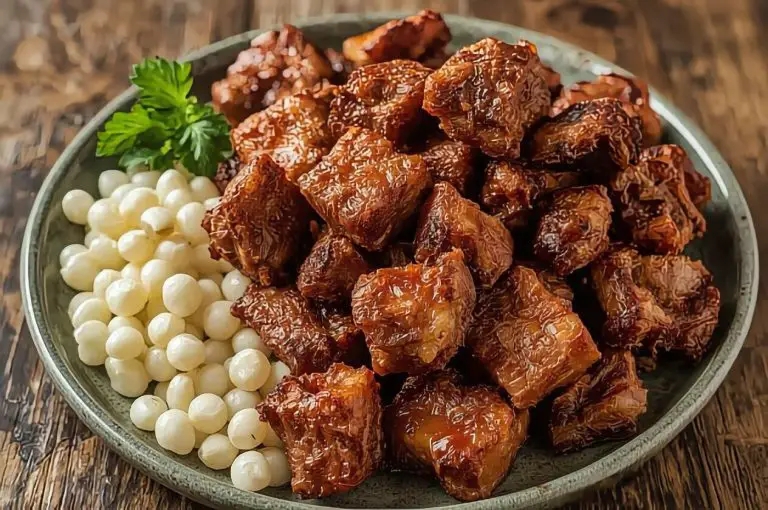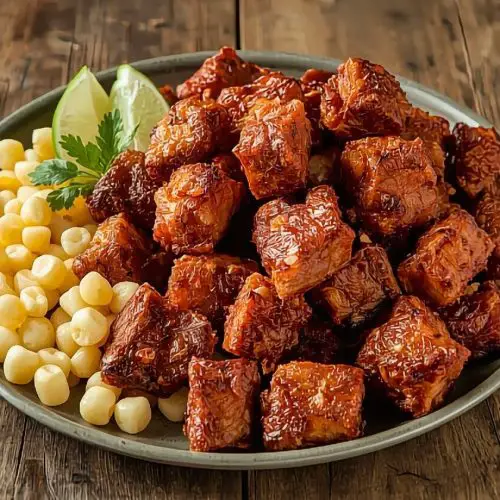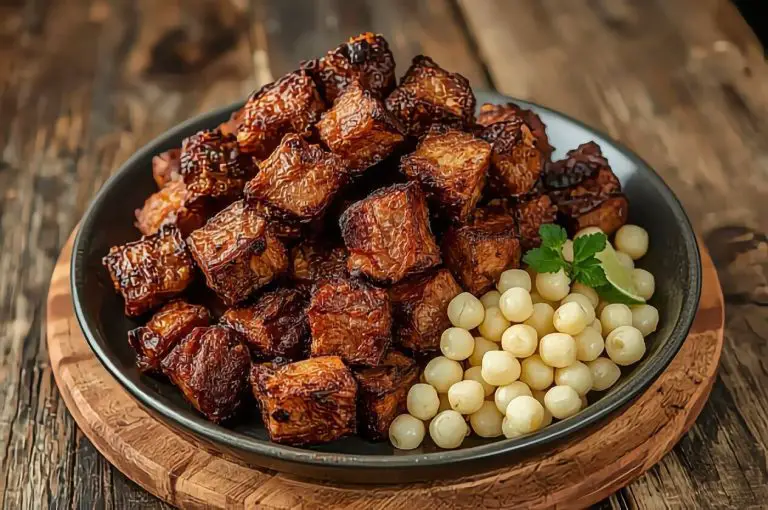Bolivian Chicharron recipe is a traditional dish that highlights the rich flavors of Bolivia through seasoned, slow-cooked pork fried in its own fat. This dish uses big cubes of pork that get boiled, seasoned, and fried until they’re crispy on the outside but still tender inside. It’s a fun mix of textures and flavors that just feels like Bolivia on a plate.
We first ran into Bolivian Chicharron in the Cochabamba valley, where people love eating it alongside local sides like hominy and freeze-dried potatoes. The recipe sticks with straightforward ingredients—garlic, cumin, oregano, and lemon juice—so it’s easy to pull off but still packed with real-deal flavor. If you’re new to Bolivian food or just want a hearty pork dish, this one really gives you a taste of Bolivia’s food traditions.
This post walks you through making Bolivian Chicharron, with some tips for cooking and serving it the way locals do. We picked up this recipe on our travels, so it’s not fussy—just good, solid food that works every time.
Key Takeways
- Bolivian Chicharron is all about seasoned pork cubes cooked slow, then fried for that perfect crispy bite.
- Simple spices and easy-to-find ingredients bring out the dish’s classic Bolivian flavor.
- You boil the pork first, then fry it in its own fat. That’s really the secret to the best texture.
Bolivian Chicharron Recipe Ingredients
Servings: 8
Prep Time: 30 Minutes
Cooking Time: 2 Hours
- 4 pounds pork shoulder, cut into large cubes
- 12 cloves garlic, minced
- 3 teaspoons ground cumin
- 2 tablespoons dried oregano
- 4 teaspoons salt
- 1 teaspoon black pepper
- 1/2 cup fresh lemon juice (about 3 large lemons)
- 1 cup beer (optional, but traditional)
- 1/4 cup fresh mint leaves
- 28 ounces hominy (mote corn), rinsed
- 16 small potatoes (like honey gold or similar), whole
- White vinegar (just a splash, for crisping at the end)

Bolivian Chicharron Recipe Cooking Instructions
Start by cutting the pork shoulder into cubes. In a big bowl, mix garlic, oregano, cumin, black pepper, and salt, then toss in the pork and coat it all over. Let the pork marinate for at least an hour—overnight is even better if you’ve got the time.
Meanwhile, rinse the mote corn and boil it in water for about an hour until it’s tender but still got a little chew. While that’s going, boil the small potatoes (keep the skins on) until they’re just fork-tender, usually 15 to 20 minutes. Both are classic sides for chicharrón.
After marinating, make a simple marinade with beer, lemon juice, and fresh mint leaves. Put the spiced pork cubes in a plastic bag and pour the marinade over. Let them soak for a couple of hours or overnight—depends how much time you want to invest.
When you’re ready to cook, heat up the grill to medium-high. Pull the pork from the marinade, shake off the excess liquid, and get those cubes on the grill. Cook them for 15 to 20 minutes, turning often, until they’re browned and cooked through.
The trick with chicharrón is to cook the pork slow, so it renders its fat and gets that crispy outside but stays juicy inside. I’d use a meat thermometer if you have one—145°F (63°C) is the safe zone.
Serve the grilled chicharrón with the boiled mote corn and potatoes. Top with some fresh mint if you’re feeling fancy, and dig in.

Bolivian Chicharron Recipe
Ingredients
- 4 pounds pork shoulder cut into large cubes
- 12 cloves garlic minced
- 3 teaspoons ground cumin
- 2 tablespoons oregano dried
- 4 teaspoons salt
- 1 teaspoon black pepper
- 1/2 cup lemon juice fresh (about 3 large lemons)
- 1 cup beer (optional, but traditional)
- 1/4 cup mint leaves fresh
- 28 ounces hominy (mote corn), rinsed
- 16 small potatoes (like honey gold or similar), whole
- White vinegar (just a splash, for crisping at the end)
Instructions
- Start by cutting the pork shoulder into cubes. In a big bowl, mix garlic, oregano, cumin, black pepper, and salt, then toss in the pork and coat it all over. Let the pork marinate for at least an hour—overnight is even better if you’ve got the time.
- Meanwhile, rinse the mote corn and boil it in water for about an hour until it’s tender but still got a little chew. While that’s going, boil the small potatoes (keep the skins on) until they’re just fork-tender, usually 15 to 20 minutes. Both are classic sides for chicharrón.
- After marinating, make a simple marinade with beer, lemon juice, and fresh mint leaves. Put the spiced pork cubes in a plastic bag and pour the marinade over. Let them soak for a couple of hours or overnight—depends how much time you want to invest.
- When you’re ready to cook, heat up the grill to medium-high. Pull the pork from the marinade, shake off the excess liquid, and get those cubes on the grill. Cook them for 15 to 20 minutes, turning often, until they’re browned and cooked through.
- The trick with chicharrón is to cook the pork slow, so it renders its fat and gets that crispy outside but stays juicy inside. I’d use a meat thermometer if you have one—145°F (63°C) is the safe zone.
- Serve the grilled chicharrón with the boiled mote corn and potatoes. Top with some fresh mint if you’re feeling fancy, and dig in.
Notes
Nutrition
Cooking Tips
If you can, marinate the pork overnight. It really helps those flavors soak in. A mix of garlic, cumin, oregano, and lemon juice is key for that Bolivian taste, and it also keeps the meat nice and tender.
Cook the mote corn separately so it stays a little chewy—just rinse it well first. This part takes about an hour, so plan ahead or start it early.
For potatoes, go with small ones like papa or even freeze-dried chuño for a more traditional vibe. Boil them whole with the skins on—they’ll stay firm and flavorful. These sides just work with chicharrón, no question.
When it’s time to fry the pork, go low and slow in its own fat. That’s how you get it crispy without drying it out. I like to hit it with a splash of white vinegar at the end for extra crunch and a little tang. It’s not mandatory, but it does something special.
Don’t skip the sauces. In Bolivia, chicharrón almost always comes with llajwa or llajua—a spicy salsa made from peppers and tomatoes. It cuts through the richness of the pork and just makes the whole thing pop.
If you want to go all in, serve it with chicha, a fermented corn drink that’s super traditional. It’s not for everyone, I’ll admit, but it really rounds out the meal.
Bolivian Chicharron Recipe FAQs
Bolivian chicharron recipe uses simple ingredients like pork, spices, and citrus. The cooking process involves boiling then frying pork in its own fat. It is often paired with corn and potatoes. Differences with other Latin versions come down to cuts of meat and seasoning. Crispiness depends on frying technique and timing.
What ingredients are required for a traditional Bolivian chicharron recipe?
The main ingredient for the Bolivian chicharron recipe is pork, usually shoulder or ribs with fat. Seasonings include garlic, oregano, cumin, salt, and black pepper. Lemon juice or beer is added after cooking. Fresh mint leaves and water are used during boiling. Corn (mote) and potatoes are common sides.
How is the Bolivian chicharron recipe traditionally prepared and served?
First, pork cubes are boiled in water with mint leaves until tender. After the water evaporates, the pork is fried in its own fat until golden and crispy. Lemon juice or beer is added at the end to seal in flavor. The Bolivian chicharron recipe is served hot with mote, potatoes, and a tomato salsa called llajua.
Can pork shoulder be used for making the authentic Bolivian chicharron recipe?
Yes, pork shoulder is the traditional cut for the Bolivian chicharron recipe. It has enough fat to render while frying. The fat helps to crisp the meat and adds flavor, making it essential to keep during cooking.
What are some common side dishes to serve with the Bolivian chicharron recipe?
Mote, a type of large white corn, is the most traditional side for the Bolivian chicharron recipe. Boiled potatoes, sometimes skin-on, are also common. Llajua, a spicy tomato-based salsa, often accompanies the dish. Some versions serve it with chuño, freeze-dried potatoes typical in Bolivia.
Is there a difference between the Bolivian chicharron recipe and other Latin American versions?
Yes, the Bolivian chicharron recipe uses larger pork chunks with fat and cooks them slowly by boiling then frying. Other countries may use pork rinds or different cuts. Seasoning and sides vary by region. Bolivia’s version includes mote and llajua, which are less common elsewhere.
What are some tips for achieving the perfect crispiness in Bolivian chicharron?
First off, don’t trim all the fat from the pork—leave some on for that classic texture. Start by boiling the pork, then let it sizzle in its own fat until every side turns a deep golden brown. I find it helps to keep stirring so nothing sticks or burns (trust me, it’s worth the effort). Right near the end, splash in a bit of beer or squeeze some lemon juice over the top. That last step? It just takes the crunch and flavor up a notch.

